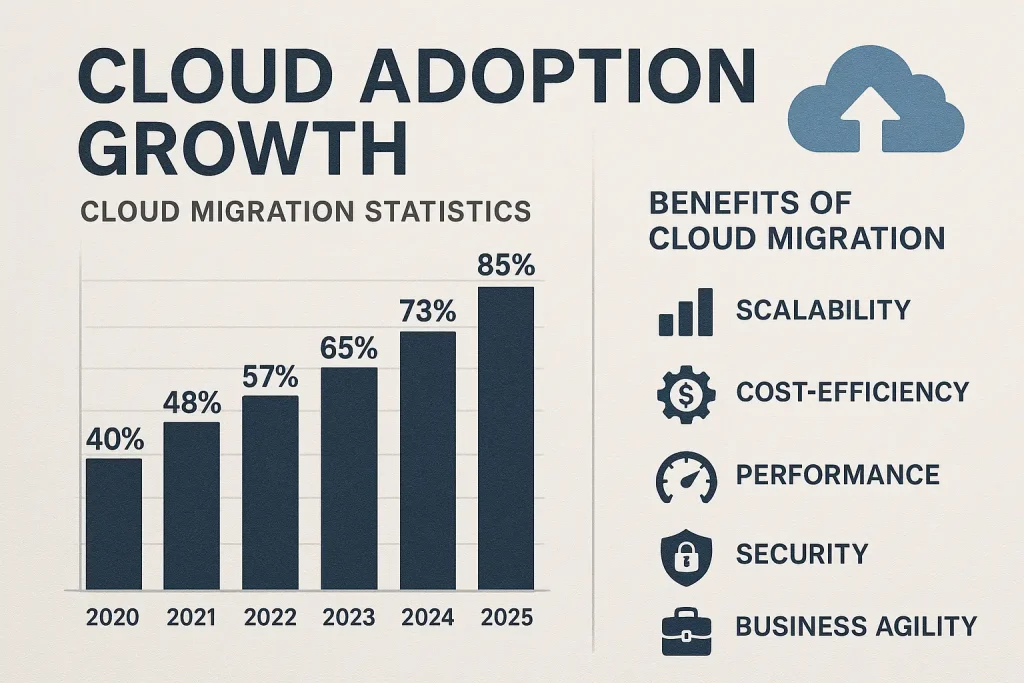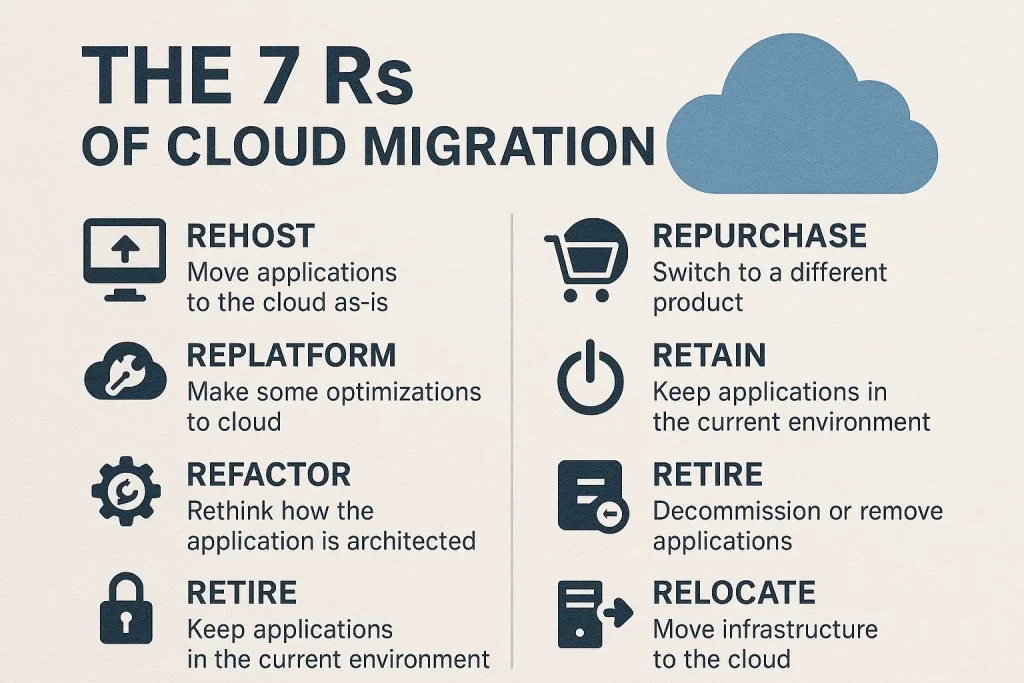As organizations increasingly recognize the transformative potential of cloud computing, the need for effective cloud migration strategies has never been more critical. This comprehensive guide explores the intricacies of cloud migration, offering insights and best practices to help businesses navigate this complex but rewarding journey.
Understanding cloud migration: definition and importance
Cloud migration involves transferring an organization’s digital assets, applications, and IT infrastructure from on-premises systems to cloud-based environments. This strategic shift enables businesses to harness the scalability, flexibility, and cost-efficiency of cloud computing platforms.
The significance of cloud migration has grown substantially as businesses seek to modernize their IT operations and gain a competitive edge. Recent statistics underscore this trend, with Gartner projecting worldwide public cloud end-user spending to reach $494.7 billion in 2022, a significant increase from $410.9 billion in 2021.
Key benefits of migrating to cloud include:
- Scalability: Easily adjust resources based on demand, eliminating the need for costly hardware investments.
- Cost-efficiency: Reduce capital expenditures on physical infrastructure and shift to a flexible operational expense model.
- Enhanced performance: Leverage high-performance computing resources and global networks for faster application performance and reduced latency.
- Robust security: Benefit from cloud providers’ substantial investments in advanced security measures.
- Business agility: Enable faster deployment of new applications and services, improving responsiveness to market changes.
It’s crucial to recognize that cloud migration is not a universal solution. Organizations must carefully evaluate their current infrastructure, applications, and business requirements to develop a tailored migration strategy.

Benefits of migrating to the cloud
While the advantages of cloud migration are numerous, it’s essential to delve deeper into how these benefits translate into tangible business value. Let’s explore the key areas where cloud migration can drive significant improvements:
Enhanced Scalability and Flexibility
Cloud environments empower businesses to:
- Implement elastic computing: Automatically scale resources to match demand, ensuring optimal performance without overprovisioning.
- Expand geographically: Deploy applications and services in new regions without physical infrastructure investments.
- Accelerate innovation: Quickly create new environments for testing and experimentation.
Cost Optimization Beyond Initial Savings
Cloud migration offers additional financial benefits:
- Utilize pay-per-use models: Only pay for consumed resources, optimizing costs in real-time.
- Decrease maintenance expenses: Shift infrastructure maintenance responsibilities to cloud providers.
- Improve energy efficiency: Leverage cloud data centers’ superior efficiency to potentially reduce carbon footprint and associated costs.
Improved Collaboration and Productivity
Cloud migration enhances teamwork and efficiency across organizations:
- Enable remote work: Access cloud-based applications and data from anywhere, supporting flexible work arrangements.
- Foster real-time collaboration: Utilize cloud-native tools for simultaneous document editing, video conferencing, and project management.
- Centralize data access: Break down information silos by consolidating data in the cloud, improving decision-making processes.
Enhanced Disaster Recovery and Business Continuity
Cloud migration significantly improves an organization’s resilience:
- Implement automated backups: Leverage robust, easily configurable cloud backup solutions.
- Ensure geo-redundancy: Replicate data and applications across multiple regions for improved availability.
- Reduce recovery times: Achieve faster Recovery Time Objectives (RTOs) compared to traditional on-premises approaches.
As we transition from understanding the benefits of cloud migration, it’s important to recognize that this journey is not without its challenges. Let’s explore the common obstacles organizations face and strategies to overcome them.

Common cloud migration challenges and how to overcome them
While the benefits of cloud migration are compelling, organizations must be prepared to address several challenges that can arise during the process. By understanding these potential obstacles and implementing effective strategies to overcome them, businesses can ensure a smoother transition to the cloud.
Data Security and Compliance
- Challenge: Ensuring data protection during transfer and storage in cloud environments.
- Solution: Implement end-to-end encryption, leverage cloud providers’ compliance certifications, and deploy additional security measures like multi-factor authentication and regular audits.
Application Compatibility and Performance
- Challenge: Maintaining or improving legacy application functionality and performance in the cloud.
- Solution: Conduct thorough application assessments, consider re-architecting or refactoring where necessary, and implement robust monitoring tools to track performance and identify optimization opportunities.
Skills Gap and Cultural Resistance
- Challenge: Addressing the lack of cloud expertise and potential resistance to change within the organization.
- Solution: Invest in training programs, consider hiring cloud specialists, and implement change management strategies to address concerns and highlight benefits for individual roles and the organization.
Cost Management and Optimization
- Challenge: Accurately forecasting cloud costs and avoiding inefficient resource allocation.
- Solution: Implement cost monitoring and optimization tools, regularly review resource allocation, and utilize auto-scaling features and reserved instances to balance performance and cost-efficiency.
With a clear understanding of both the benefits and challenges of cloud migration, organizations can develop more effective strategies for their transition. One framework that provides a structured approach to cloud migration is the “7 Rs” model, which we’ll explore in detail next.

The 7 Rs of cloud migration: comprehensive strategies explained
The “7 Rs” framework provides organizations with a structured approach to cloud migration, each strategy offering unique advantages based on specific needs and constraints:
- Rehost (Lift and Shift): Moving applications to the cloud without significant architectural changes.
- Replatform (Lift, Tinker, and Shift): Making minor adjustments to applications to leverage cloud infrastructure while maintaining core architecture.
- Refactor (Re-architect): Significantly modifying or rewriting applications to fully utilize cloud-native features.
- Repurchase (Drop and Shop): Replacing existing applications with cloud-based SaaS alternatives.
- Retain: Keeping certain applications on-premises, either temporarily or long-term.
- Retire: Decommissioning applications that no longer provide value to the business.
- Relocate (Hypervisor-Level Lift and Shift): Moving virtual machines to the cloud without altering the underlying hypervisor.
Understanding these cloud migration strategies is crucial, but implementing them effectively requires a well-structured migration plan. Let’s explore how to develop such a plan to ensure a successful cloud migration journey.

Developing a robust cloud migration plan
A well-structured cloud migration plan is essential for navigating the complexities of moving IT infrastructure to the cloud while minimizing disruptions. Key components include:
- Assessment and Discovery: Conduct a thorough inventory of your current IT landscape, including application dependencies, data volumes, and security requirements.
- Goal Setting and KPI Definition: Clearly articulate migration objectives and define key performance indicators to measure success.
- Strategy Selection: Determine the most appropriate migration strategy for each application or workload using the 7 Rs framework.
- Resource Allocation: Identify the human and financial resources required for the migration.
- Risk Assessment and Mitigation: Develop a comprehensive risk management plan addressing data security, performance, and business continuity.
- Timeline and Phasing: Create a detailed migration schedule, considering interdependencies and critical business periods.
- Testing and Validation Strategy: Develop a comprehensive testing plan covering functionality, performance, security, and user acceptance.
- Training and Change Management: Prepare your organization for the transition with targeted training programs and communication plans.
With a solid plan in place, organizations can move forward with confidence. To ensure no critical steps are overlooked, let’s break down the cloud migration process into a detailed checklist.
Cloud migration steps: a detailed checklist
This comprehensive checklist will guide you through each phase of the cloud migration process, ensuring a thorough and systematic approach:
1. Pre-Migration Phase
- Finalize cloud provider selection
- Establish a cloud governance framework
- Set up cloud environment
- Create a detailed migration roadmap
2. Preparation and Planning
- Conduct application dependency mapping
- Determine migration wave sequence
- Develop migration runbooks
- Set up monitoring and alerting
3. Migration Execution
- Perform data migration
- Execute application migration
- Conduct real-time testing
- Manage DNS and network cutover
4. Post-Migration Optimization
- Perform thorough post-migration testing
- Optimize cloud resource allocation
- Implement cloud-native features
- Decommission legacy systems
5. Continuous Improvement and Management
- Establish ongoing monitoring and alerting
- Implement automated scaling and self-healing
- Conduct regular security audits
- Optimize costs
While this checklist provides a solid foundation, successful cloud migration also relies on adhering to industry best practices. Let’s explore these practices to further enhance your migration strategy.
Best practices for successful cloud migration
To enhance your cloud migration journey, consider these best practices:
- Establish a Cloud Center of Excellence (CCoE): Create a cross-functional team to guide cloud strategy, governance, and best practices.
- Implement a Cloud-Native Security Model: Adopt a comprehensive security approach tailored to cloud environments.
- Leverage Infrastructure as Code (IaC): Manage and provision cloud infrastructure through code for improved consistency and scalability.
- Adopt a DevOps Culture: Foster collaboration between development and operations teams to accelerate deployment and improve system reliability.
- Implement Robust Monitoring and Observability: Utilize comprehensive monitoring tools to gain deep insights into your cloud environment’s health and performance.
- Prioritize Data Management and Governance: Implement robust data classification, retention, and compliance practices in the cloud.
- Embrace Continuous Optimization: Regularly review and refine your cloud infrastructure to maximize efficiency and cost-effectiveness.
With these best practices in mind, let’s delve into the specific considerations for migrating applications to the cloud, as this process often presents unique challenges and opportunities.
Application migration to the cloud: strategies and considerations
Application migration to the cloud presents unique challenges and opportunities. Key considerations include:
- Assessing Application Suitability: Evaluate each application’s architecture, dependencies, data sensitivity, and performance requirements.
- Choosing the Right Migration Strategy: Select the most appropriate approach from the 7 Rs framework for each application.
- Addressing Application-Specific Challenges: Consider issues like stateful vs. stateless applications, database migration, and API management.
- Leveraging Cloud-Native Features: Explore opportunities to enhance applications using cloud-specific services and architectures.
While application migration is crucial, it’s equally important to have a solid strategy for migrating data to the cloud. Let’s explore the key considerations for data migration in cloud environments.
Data migration strategies for cloud environments
Data migration is often one of the most complex aspects of a cloud migration project. Key strategies and considerations include:
- Comprehensive Data Assessment: Conduct a thorough inventory and analysis of your data landscape.
- Data Cleansing and Preparation: Use the migration as an opportunity to clean and optimize your data.
- Robust Security Measures: Implement end-to-end encryption and access controls throughout the migration process.
- Phased Migration Approach: Consider migrating data in stages to minimize risk and disruption.
- Continuous Data Replication: Implement real-time data synchronization between on-premises and cloud environments for a smooth transition.
- Compliance Adherence: Ensure your data migration strategy aligns with relevant regulatory requirements.
With a solid understanding of application and data migration strategies, it’s valuable to explore specific cloud platforms and their migration tools. Let’s take a closer look at Amazon Web Services (AWS) and its comprehensive suite of migration solutions.
AWS migration strategy: leveraging Amazon Web Services for cloud migration
Amazon Web Services (AWS) offers a comprehensive suite of tools and services to support cloud migration:
- AWS Migration Hub: A central interface for tracking migration progress.
- AWS Application Discovery Service: Helps gather information about on-premises data centers.
- AWS Database Migration Service (DMS): Supports both homogeneous and heterogeneous database migrations.
- AWS Server Migration Service (SMS): Automates the migration of on-premises virtual machines to AWS.
- AWS DataSync: Simplifies and accelerates data transfer between on-premises storage and AWS.
AWS also offers the Migration Acceleration Program (MAP) to help organizations create a strong operational foundation for moving to AWS and implementing best practices.
As we near the end of our comprehensive guide, it’s crucial to remember that the cloud migration journey doesn’t end once your workloads are in the cloud. Let’s explore the critical phase of post-migration optimization and management.
Post-migration: optimizing and managing your cloud environment
The work doesn’t end once your workloads are in the cloud. Post-migration optimization and management are critical for realizing the full potential of cloud computing:
- Continuous Optimization: Regularly analyze and adjust resource allocations to match actual needs.
- Enhanced Monitoring and Observability: Implement advanced monitoring tools and AIOps for proactive issue detection and resolution.
- Security and Compliance: Maintain ongoing security measures and compliance monitoring in the dynamic cloud environment.
- Cost Management and FinOps: Adopt FinOps practices to optimize cloud spending and align it with business objectives.
- Disaster Recovery and Business Continuity: Implement robust DR strategies leveraging cloud capabilities.
As we conclude our exploration of cloud migration strategies, let’s reflect on the key takeaways and look towards the future of cloud computing.
Conclusion: embracing the future with effective cloud migration
Cloud migration is a transformative journey that impacts every aspect of an organization. As cloud technologies continue to evolve, so too must our strategies for harnessing their power. Key takeaways include:
- The importance of a holistic approach to cloud migration, encompassing comprehensive planning, strategic execution, and continuous optimization.
- The need to address emerging challenges such as data privacy, multi-cloud complexity, and the ongoing skills gap.
- The role of cloud computing as a cornerstone of broader digital transformation efforts, enabling rapid innovation and improved business agility.
By embracing best practices, leveraging innovative technologies, and maintaining a focus on continuous improvement, organizations can unlock the full potential of cloud computing and drive significant business value for years to come. As you embark on your cloud migration journey, consider exploring additional resources such as ergonomic mouse guides to ensure your team’s comfort and productivity during the transition and beyond.
References
- Gartner. (2022). Gartner Forecasts Worldwide Public Cloud End-User Spending to Reach Nearly $500 Billion in 2022. https://www.gartner.com
- AWS. (2023). Cloud Migration.
- Microsoft Azure. (2023). Cloud Migration Strategy.


